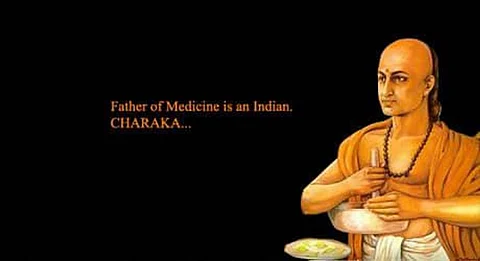
- Home
- न्यूजग्राम
- NewsGram USA
- India
- World
- Politics
- Entertainment
- Culture
- Lifestyle
- Economy
- Sports
- Sp. Coverage
- Misc.
- NewsGram Exclusive
- Jobs / Internships

By Gaurav Sharma
Acharya Charaka, contributors to Ayurveda, a system of medicine and lifestyle developed in Ancient India. Most people regard Hippocrates (460-377 BC) as the father of medicine, but only a few are aware of the novel contributions made by a man named Charaka "Indian father of Medicine" in the way the human anatomy and physiology is perceived to function.
Long before the birth of Hippocrates in the early centuries of the common era, Charaka authored a medical treatise called Charaka Samhita or the compendium of Charaka.
The ancient medical manual "charaka samhita", regarded by many in the West as an 'Alternative Medicine' manuscript, is a guide on how to live a healthy life. Simply put, the Charaka Samhita is a guidebook of preventive medicine.
The compilation of medical treatise enshrined in the Samhita, also forms a foundational text for the ancient science of Ayurveda or the 'knowledge of long life.'
Widely respected and translated in the traditional medical field (particularly during the Arab and the Roman empire), Ayurveda is the best known among the three medical traditions of the Indian sub-continent, the other being the Unani and Siddha schools.
The Ayurveda lays down a well-structured and well-defined view of medicine by segregating it into a series of eight disciplines, namely:
Such is the immense wealth of health information expounded in the Ayurveda, that it is sometimes compared to the works of Galileo, Archimedes, and Euclid in their respective fields.
Ayurveda is one of the invisible pillars, which balances the dysfunctional public health system of India. It has become an important part of the government policy, with an independent ministry known as AYUSH, dedicated to the research and education of Ayurvedic healthcare.
Apart from modern western healthcare centers, a revolution of tele-ayurvedic-health centers has taken India by storm.
Comprising of hired tele-operators, these traditional health centers essentially come in the shape of a village house with divisions of mud walls and bamboo sticks.
Those inflicted with diseases call up the center, the staff listens to their problems, and after consulting the Charaka Samhita, they prescribe ayurvedic medications to the patients.
The emphasis on listening to the patients rather than sending them off for pathological tests is based on Charaka's philosophy of medical examination, that of finding the root cause of disorder through a series of questions and answers, reminiscent of a dialogue between the teacher and a disciple.
These traditional health-centers exemplify the efficient use of modern technology and communication networks to popularize the ancient knowledge of Ayurveda.
Ayurveda is still, however, poles apart from how modern medicine visualizes the human body and the way it functions.
The operating principles of Ayurveda utilise the concept of the body's basic doshas or humors. These include the element of movement through Vita or bile, transformation in the form of Pitta or phlegm and stability and lubrication via Kapha or wind.
Disturbing these elements from their proper location means inviting an illness to follow suit. To prevent such a calamity from happening, Charaka prescribes some practical yet deeply meaningful metaphysical strictures.
The practice of mindfulness, exercising good judgment, calming the senses, being aware of time, place and the self apart from inculcating a good lifestyle are some of the tips that Charaka postulates for imbibing good health.
The notion of Deha-Prakriti, which means 'the nature of the body,' distinguishes Charaka's Ayurveda as a highly personalised medical discipline.
Each person at the time of conception is thought to be endowed with a particular nature (Prakriti), which determines his predisposition to diseases. This justifies the immense emphasis paid on the history of a person while prescribing medication.
The nature of wisdom and its exercise is another factor that is central to Charaka's concept of good health. For this reason, as much for the practical aspects of his encyclopedic work, Charaka become quite popular during the early 19th Century.
Charaka mania fueled the circle of doctors in New York to establish a Charaka Club. This inexplicably filtered to the educated nationalist Indian elite who were searching and yearning to discover their historical roots.
Irrespective of the such drifting upheavals, what sets Charaka's monumental work uniquely apart from modern medical science and indeed from the medical profession itself, is its farsightedness to visualize the body as a part of a vast, natural and cosmic system of causality.
Urban India, with its concomitant stress and competition, can find solace by embracing Charaka's teachings on healthy living, and thereby avoid the sight of a medical complex for good.
